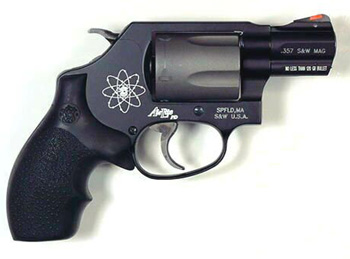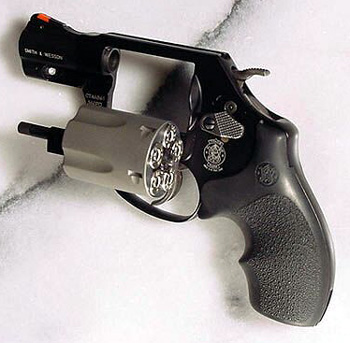 By Dan Smith – genitron.com
By Dan Smith – genitron.com
I’m relatively new to revolvers. Being a semi-automatic man for many years, I only have one revolver in my gun collection. That’s been a Smith & Wesson Model 66 .357 Magnum service revolver. Not a small gun, and with reasonable weight, this gun has none-the-less been a joy to shoot at the range, being quite capable of absorbing the power of a .357 Magnum round. This would be a nice home defense gun, and would be a reliable piece to have for camping or hiking. But, I wouldn’t consider it a good concealed carry weapon for self-defense. It’s just too big.
And my focus here is on self-defense. I’m not a hunter, so you won’t see me reviewing the likes of the Smith & Wesson Model 500 for instance. Nor will I probably ever review a .480 Ruger or .454 Casull model. These are big hunting guns, and I’ll let others review those models. So, for my first review of a revolver for self-defense, I jumped right into it and acquired the Smith & Wesson Airweight 360PD super-lightweight revolver.
Introduced in 2002, this small, lightweight revolver is built from Smith & Wesson’s “J” frame design which has a lineage that goes all the way back to 1950 with the introduction of their Model 36 “Chiefs Special”. The key feature of this “J” frame model is the use of exotic alloys in its frame and cylinder construction, producing one of the lightest revolvers on the market.
Specifications –
Caliber: .357 Magnum, .38 Special +P, .38 Special
Action: revolving chamber
Length: 6.375 in
Width: 1.312 in
Height: 4.25 in
Cylinder Capacity: 5 rounds
Barrel Length: 1.875 in
Rifling: 5-grooves, RH twist
Trigger: double-action
Sights: red ramp front, fixed notch rear
Weight Empty: 11.3 oz
Weight Loaded: 13.7oz
Features –
Titanium cylinder.
Scandium/aluminum alloy frame.
Black anodized finish.
Stainless steel barrel tube.
Hogue Bantam Monogrip.
Click HERE to see the full line of Smith & Wesson revolvers.
 Design Notes –
Design Notes –
The frame of the 360PD is constructed from a scandium reinforced aluminum alloy. Scandium, a novel alloying element for aluminum, is mined and processed in Zhovti Vody, Ukraine, the only primary scandium mine in operation in the world. The key properties of this alloy are light weight, superior strength and good resistance to corrosion. The frame is topped off with a smooth black anodized finish.
The titanium cylinder weighs just 60% of what a similar stainless steel cylinder weighs and yet is able to withstand the same operating pressures. As with all “J” frame designs, this is a swing-out cylinder with an axial pin driven star extractor. The extractor pin rests in a slot in the bottom of the barrel shroud when the cylinder is closed.
The barrel is a hybrid construction consisting of a scandium/aluminum alloy shroud keyed into the frame with a metal tab, and a stainless steel barrel tube which is screwed into the frame with a special tool, holding the shroud in place.
The grip is a Hogue Bantam Monogrip, a one-piece wrap-around construction that is held into place by being pressed into a stock pin that extrudes from both sides of the frame near the base of the butt.
The Caliber –
The .38 Special cartridge was developed by Smith & Wesson and was introduced with its Military & Police Model revolver in 1899. It is considered one of the best-balanced, all-round handgun cartridges ever designed. It is also one of the most accurate and very widely used for match shooting. This subsonic round is available with bullet weights ranging from 95 to 200 grains.
The .357 Magnum cartridge was introduced in 1935 by Smith & Wesson for its heavy-frame revolver. Ammunition was developed by Winchester in cooperation with Smith & Wesson using a lengthened and strengthened version of the .38 Special case. While it has less power than .44 Magnum, it compares favorably to the .45 ACP, but with better armor penetration. Today factories offer over fifty different loadings in this caliber. Bullet weights range from 110 to 200 grains with an average muzzle energy exceeding 500 ft-lbs.
The following data set is based on standard factory loaded cartridges fired from a 4″ barrel, listed by weight, brand, type and muzzle velocity. This is only a very small sample of what is available.
.38 Special
123 grain Norma FMJ : 886 Feet Per Second
132 grain PMC FMJ : 841 Feet Per Second
158 grain MagTech SJHP : 890 Feet Per Second
125 grain Federal JSP+P : 900 Feet Per Second
158 grain CCI-Speer FMJ+P : 900 Feet Per Second
.357 Magnum
125 grain Remington JHP : 1220 Feet Per Second
158 grain Norma FMJ : 1214 Feet Per Second
180 grain Winchester JHP : 1180 Feet Per Second
Handgun Observations –
I should first note that in the description of the .357 Magnum cartridge above I mention a bullet weight range that goes as low as 110 grains. You will notice that engraved on the right side of the 360PD barrel is the statement “NO LESS THAN 120 GR BULLET”. This statement refers to .357 Magnum rounds only, not .38 Special rounds, and there is an interesting reason for this restriction. Magnum bullets that weigh less than 120 grains will exit their cartridge before the cartridge charge has a chance to completely burn. This charge will leak out onto the cylinder and frame while still burning, causing damaging oxidation to the gun’s exotic materials over time.
My initial observation of the 360PD was that the grip was obviously too small. But, I based this observation on my experience with many sub-compact semi-automatics whose standard grips are usually just shortened. Those grips are typically fat and straight as they house the gun’s ammo, and the grip stance usually leaves the little finger hanging. The grip on the 360PD though, has a small diameter and is ergonomically curved to fit deep within the palm of the hand. All of your fingers wrap fully around the grip and make good contact, including the little finger.
The 360PD’s sister, the 340PD, is basically the same revolver but with a spurless hammer, making the 340PD a double-action-only revolver. I chose the 360PD for its ability to fire in both double-action and single-action modes. Although the spurless hammer was designed to minimize snagging while being carried concealed, after a month of carrying the 360PD in-the-waistband I found no problems with the exposed hammer spur. In fact, when drawing the gun I found my thumb falling naturally next to the hammer spur, not only protecting it from snags but also staging my thumb for quick cocking during the draw for single-action firing.
I was surprisingly pleased with this with this little 5-round revolver. In my opinion it is quite adequate as a self-defense weapon. Having carried it for a full month, I am very comfortable with it, and now include it in my cache of weapons that I regularly use for concealed carry. I have a new appreciation for revolvers.
One note about cleaning Although the black anodized frame cleans easily, as well as the stainless steel barrel, I found it extremely difficult to remove gunshot residue from the somewhat porous surface of the titanium cylinder. I tried every gun solvent and cleaner I had with no success. What finally worked for me came from my car cleaning supplies. A small dab of magnesium and aluminum rim polish lifted the stains right off the cylinder.
Shooting –
With a barrel length under two inches and a sight radius under four inches, it was difficult for me to even hit a small target at 25 yards. Those with a more steady hand and sharper vision my have better luck than I had. But from my perspective, I consider this gun a short range weapon, and I limited my range tests to only 7 yards. Although the gun is rated for .357 Magnum rounds, after shooting just one box of fifty 125 grain rounds through the 360PD, the .357 Magnum recoil left me with a very sore wrist. Surprisingly, my palm and grip remained unaffected, which says a lot about the small Hogue Bantam grip. Firing .38 Special standard and +P rounds through the 360PD, on the other hand was quite an enjoyable experience. I have opted to stay with .38 Special+P rounds when carrying this weapon.
In double-action mode the trigger pull reaches a peak of 15.5 pounds at the mid point of its 3/4 inch of travel. It then drops to 4.5 pounds where it breaks to fire during the last 1/8 inch of travel. Short of the at-rest hammer block there is no other safety. In single-action mode when the hammer is drawn, the trigger moves all the way back to that final 1/8 inch of travel, where it sets, requiring just a slight 4.5 pound pull to fire the weapon.
Often I found I was able to pull through the 15.5 pound double-action travel, and then stop just short of the 4.5 pound break, holding to take aim just before firing. But occasionally I would un-intentionally pull through, prematurely firing the gun. Trying to pull straight through the 15.5 pound travel non-stop to fire the gun brought the worst results. In practice I found that the best control and accuracy for me resulted from drawing the hammer manually to single-action mode before firing.
This article is used by permission of the author
Visit his site. It’s a wealth of information

Comments, suggestions, contributions? Contact me here